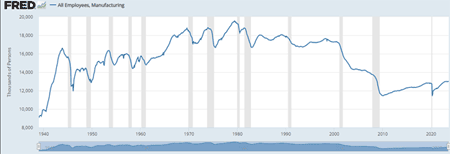A Look at the State of US Manufacturing
As you may or may not have known, October 6 was National Manufacturing Day, which seems like a reasonable trigger to take a look at the current state of US manufacturing.
And I will just say your perspective changes depending on what questions you ask, and what data you reference.
| GILMORE SAYS: |
WHAT DO YOU SAY?
At about 13 million currently, US manufacturing jobs are up 1.5 million from those bottoms, but still well below the numbers of even a decade and a half ago.
Send Us Your Feedback here
|
My unfortunate conclusion: US manufacturing remains modestly in decline, and it is unclear if the always "just around the corner" reshoring paradigm will ever really gain traction.
In conjunction with Manufacturing Day, the US Chamber of Commerce published an optimistic blog post that cited a variety of data points, summarized below.
For example, the Chamber says that in contrast to the "we don't make anything here" refrain commonly heard in Washington, US industrial production has risen by two-thirds in the past 30 years in inflation-adjusted terms. I will have some comment on that a bit later.
The Chamber also says US manufacturing has bounced back from the pandemic recession and today employs 13 million Americans, with average earnings topping $33 per hour.
American exports of manufactured goods reached nearly $1.3 trillion in 2022, a sum representing nearly half the manufacturing sector's total output. That means nearly half of everything made in American factories is destined for consumers overseas.
There are some other bright signs. As we reported earlier this year, new US factory construction has recently been up big, reaching $108 billion in investment in 2022, Census Bureau data show, the highest annual total ever. The number continued to be strong in Q1 2023, the last period for which I can find data.
One could naturally assume increased factory construction will eventually show up as increased manufacturing output as the plants come on line.
There continues to be a lot of chatter about a variety of factors - notably a reduction in supply chain risk - driving increase reshoring strategies, with survey after survey finding a high percentage of manufacturers mulling or pursuing moving at least some production back to US soil.
The above represents that the positive view. Here is a more pessimistic view.
The Federal Reserve Bank puts out a monthly index tracking US manufacturing sector output. The index tracks that output versus a baseline year, currently 2017, which is given an index value of 100.
The index for September, released last week, came in right about 99, the level it has been hovering around all year.
The good news is that being flat is a lot better than a decline, which might indicate the long predicted recession that never shows up.
But is also means US manufacturing curently remains slightly below the baseline year nearly seven years later. There has been no growth.
I am sorry, but that is hardly a bullish story. The current level of output is also well below the all-time index high of about 108 seen in late 2007.
It is also a mixed story with regard to manufacturing employment, shown in data summarized by the Federal Reserve Bank of St. Louis since the 1940s in the chart below:

Source: Federal Reserve Bank St. Louis
As can be seen, the peak was reached in 1979, at about 19.5 million workers, before starting a long decline, bottoming in December 2009 and then again in April 2020, at about 11.5 million.
At about 13 million currently, US manufacturing jobs are up 1.5 million from those bottoms, but still well below the numbers of even a decade and a half ago.
With regards to exports, the US trade deficit in goods continues to be high. In 2022 it was $1.17 trillion (with a T), versus $1.07 trillion in 2021.
As I continue to say, while there are many anecdotes and as noted above regular support in surveys, reshoring as a real trend is just not yet showing up in the numbers.
So I think I will end it here. My view is that US manufacturing is holding its own, meaning flat, but that better than decades of decline, driven primarily by automation and other productivity gains, and then, starting about the year 2000, offshoring.
I think we need to do more to revive it, and robots will be part of the answer.
Any reaction to these US manufacturing numbers? Let us know your thoughts at the Feedback button or section below.
|

